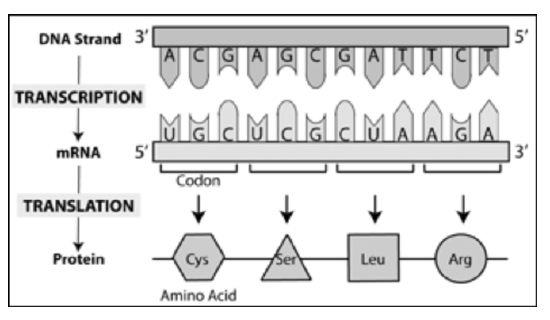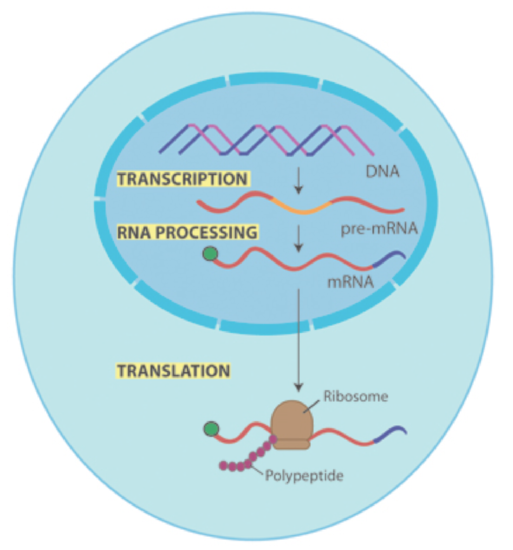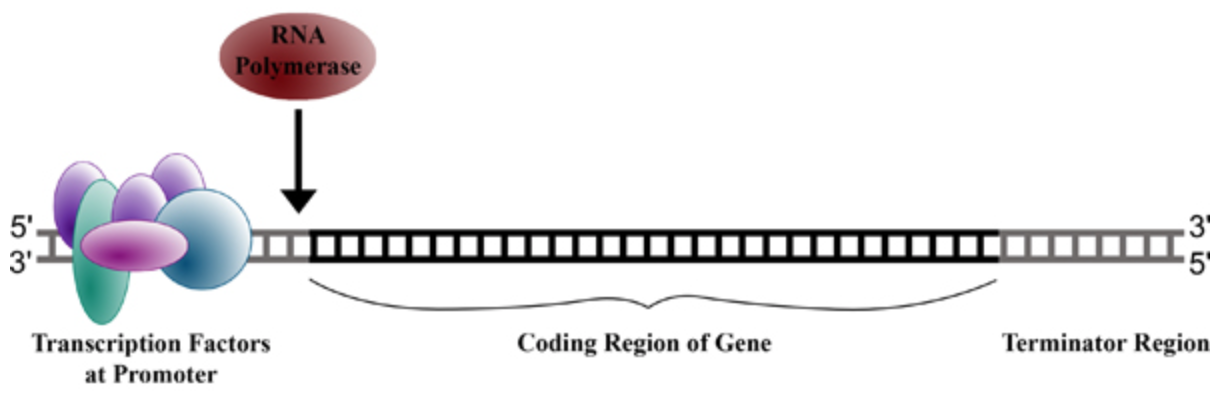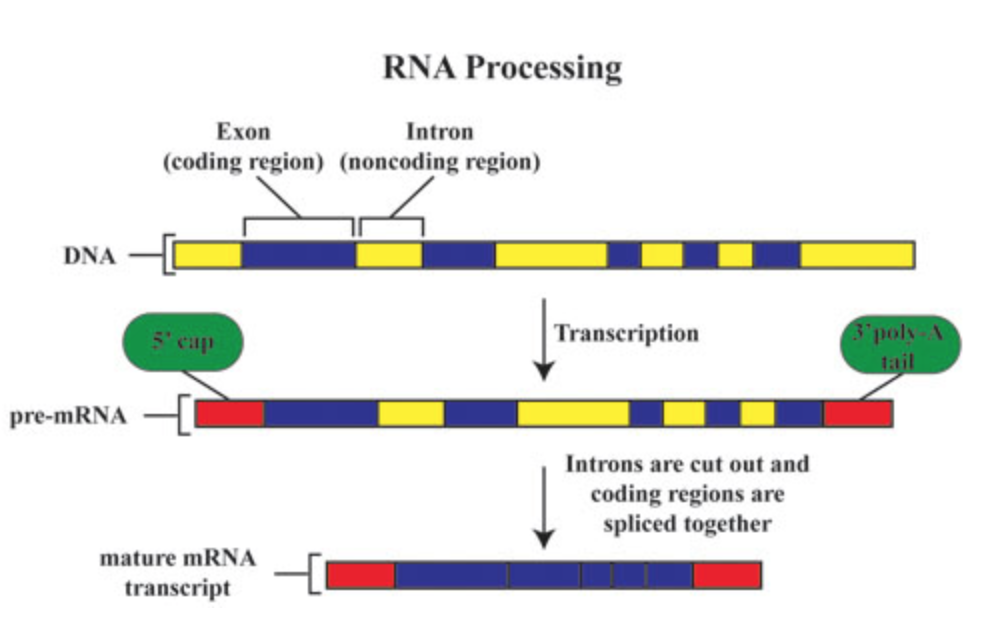Transcription
- Page ID
- 23906
\( \newcommand{\vecs}[1]{\overset { \scriptstyle \rightharpoonup} {\mathbf{#1}} } \)
\( \newcommand{\vecd}[1]{\overset{-\!-\!\rightharpoonup}{\vphantom{a}\smash {#1}}} \)
\( \newcommand{\dsum}{\displaystyle\sum\limits} \)
\( \newcommand{\dint}{\displaystyle\int\limits} \)
\( \newcommand{\dlim}{\displaystyle\lim\limits} \)
\( \newcommand{\id}{\mathrm{id}}\) \( \newcommand{\Span}{\mathrm{span}}\)
( \newcommand{\kernel}{\mathrm{null}\,}\) \( \newcommand{\range}{\mathrm{range}\,}\)
\( \newcommand{\RealPart}{\mathrm{Re}}\) \( \newcommand{\ImaginaryPart}{\mathrm{Im}}\)
\( \newcommand{\Argument}{\mathrm{Arg}}\) \( \newcommand{\norm}[1]{\| #1 \|}\)
\( \newcommand{\inner}[2]{\langle #1, #2 \rangle}\)
\( \newcommand{\Span}{\mathrm{span}}\)
\( \newcommand{\id}{\mathrm{id}}\)
\( \newcommand{\Span}{\mathrm{span}}\)
\( \newcommand{\kernel}{\mathrm{null}\,}\)
\( \newcommand{\range}{\mathrm{range}\,}\)
\( \newcommand{\RealPart}{\mathrm{Re}}\)
\( \newcommand{\ImaginaryPart}{\mathrm{Im}}\)
\( \newcommand{\Argument}{\mathrm{Arg}}\)
\( \newcommand{\norm}[1]{\| #1 \|}\)
\( \newcommand{\inner}[2]{\langle #1, #2 \rangle}\)
\( \newcommand{\Span}{\mathrm{span}}\) \( \newcommand{\AA}{\unicode[.8,0]{x212B}}\)
\( \newcommand{\vectorA}[1]{\vec{#1}} % arrow\)
\( \newcommand{\vectorAt}[1]{\vec{\text{#1}}} % arrow\)
\( \newcommand{\vectorB}[1]{\overset { \scriptstyle \rightharpoonup} {\mathbf{#1}} } \)
\( \newcommand{\vectorC}[1]{\textbf{#1}} \)
\( \newcommand{\vectorD}[1]{\overrightarrow{#1}} \)
\( \newcommand{\vectorDt}[1]{\overrightarrow{\text{#1}}} \)
\( \newcommand{\vectE}[1]{\overset{-\!-\!\rightharpoonup}{\vphantom{a}\smash{\mathbf {#1}}}} \)
\( \newcommand{\vecs}[1]{\overset { \scriptstyle \rightharpoonup} {\mathbf{#1}} } \)
\( \newcommand{\vecd}[1]{\overset{-\!-\!\rightharpoonup}{\vphantom{a}\smash {#1}}} \)
\(\newcommand{\avec}{\mathbf a}\) \(\newcommand{\bvec}{\mathbf b}\) \(\newcommand{\cvec}{\mathbf c}\) \(\newcommand{\dvec}{\mathbf d}\) \(\newcommand{\dtil}{\widetilde{\mathbf d}}\) \(\newcommand{\evec}{\mathbf e}\) \(\newcommand{\fvec}{\mathbf f}\) \(\newcommand{\nvec}{\mathbf n}\) \(\newcommand{\pvec}{\mathbf p}\) \(\newcommand{\qvec}{\mathbf q}\) \(\newcommand{\svec}{\mathbf s}\) \(\newcommand{\tvec}{\mathbf t}\) \(\newcommand{\uvec}{\mathbf u}\) \(\newcommand{\vvec}{\mathbf v}\) \(\newcommand{\wvec}{\mathbf w}\) \(\newcommand{\xvec}{\mathbf x}\) \(\newcommand{\yvec}{\mathbf y}\) \(\newcommand{\zvec}{\mathbf z}\) \(\newcommand{\rvec}{\mathbf r}\) \(\newcommand{\mvec}{\mathbf m}\) \(\newcommand{\zerovec}{\mathbf 0}\) \(\newcommand{\onevec}{\mathbf 1}\) \(\newcommand{\real}{\mathbb R}\) \(\newcommand{\twovec}[2]{\left[\begin{array}{r}#1 \\ #2 \end{array}\right]}\) \(\newcommand{\ctwovec}[2]{\left[\begin{array}{c}#1 \\ #2 \end{array}\right]}\) \(\newcommand{\threevec}[3]{\left[\begin{array}{r}#1 \\ #2 \\ #3 \end{array}\right]}\) \(\newcommand{\cthreevec}[3]{\left[\begin{array}{c}#1 \\ #2 \\ #3 \end{array}\right]}\) \(\newcommand{\fourvec}[4]{\left[\begin{array}{r}#1 \\ #2 \\ #3 \\ #4 \end{array}\right]}\) \(\newcommand{\cfourvec}[4]{\left[\begin{array}{c}#1 \\ #2 \\ #3 \\ #4 \end{array}\right]}\) \(\newcommand{\fivevec}[5]{\left[\begin{array}{r}#1 \\ #2 \\ #3 \\ #4 \\ #5 \\ \end{array}\right]}\) \(\newcommand{\cfivevec}[5]{\left[\begin{array}{c}#1 \\ #2 \\ #3 \\ #4 \\ #5 \\ \end{array}\right]}\) \(\newcommand{\mattwo}[4]{\left[\begin{array}{rr}#1 \amp #2 \\ #3 \amp #4 \\ \end{array}\right]}\) \(\newcommand{\laspan}[1]{\text{Span}\{#1\}}\) \(\newcommand{\bcal}{\cal B}\) \(\newcommand{\ccal}{\cal C}\) \(\newcommand{\scal}{\cal S}\) \(\newcommand{\wcal}{\cal W}\) \(\newcommand{\ecal}{\cal E}\) \(\newcommand{\coords}[2]{\left\{#1\right\}_{#2}}\) \(\newcommand{\gray}[1]{\color{gray}{#1}}\) \(\newcommand{\lgray}[1]{\color{lightgray}{#1}}\) \(\newcommand{\rank}{\operatorname{rank}}\) \(\newcommand{\row}{\text{Row}}\) \(\newcommand{\col}{\text{Col}}\) \(\renewcommand{\row}{\text{Row}}\) \(\newcommand{\nul}{\text{Nul}}\) \(\newcommand{\var}{\text{Var}}\) \(\newcommand{\corr}{\text{corr}}\) \(\newcommand{\len}[1]{\left|#1\right|}\) \(\newcommand{\bbar}{\overline{\bvec}}\) \(\newcommand{\bhat}{\widehat{\bvec}}\) \(\newcommand{\bperp}{\bvec^\perp}\) \(\newcommand{\xhat}{\widehat{\xvec}}\) \(\newcommand{\vhat}{\widehat{\vvec}}\) \(\newcommand{\uhat}{\widehat{\uvec}}\) \(\newcommand{\what}{\widehat{\wvec}}\) \(\newcommand{\Sighat}{\widehat{\Sigma}}\) \(\newcommand{\lt}{<}\) \(\newcommand{\gt}{>}\) \(\newcommand{\amp}{&}\) \(\definecolor{fillinmathshade}{gray}{0.9}\)1. Description of Transcription
Genes contain the instructions a cell needs to make proteins. Making proteins from DNA requires a 2-step process:
- Transcription: the process of copying the gene’s DNA into RNA.
- Translation: the process of using RNA to synthesize protein.
Taken together, these two steps make up the “central dogma” of biology:

Figure \(\PageIndex{1}\). (CC BY-NC-SA)

Figure \(\PageIndex{2}\). (CC BY-NC-SA)
Transcription and processing of the newly made mRNA occurs in the nucleus of the cell.
Once a mature mRNA transcript is made it is transported to the cytoplasm for translation into protein.

Figure \(\PageIndex{3}\). (CC BY-NC-SA)
Important Players in Transcription
DNA: provides the instructions to make the RNA transcript. Contains the nucleotides A, G, C and T.
messenger RNA (mRNA): RNA copy of DNA that will later be translated into a protein. Contains the nucleotides A, G, C and U.
RNA Polymerase: enzyme responsible for copying DNA into RNA.
Transcription factors: bind to the promoter region, recruiting and aiding RNA Polymerase in the initiation of transcription.
Gene Transcription: DNA to RNA
There are 3 stages involved in the process of transcription: initiation, elongation and termination.
Initiation: Transcription factors bind the promoter region of a gene. The promoter region indicates the beginning of gene, the start point for transcription. RNA Polymerase, the molecule responsible for copying the DNA into RNA, binds to the complex of transcription factors at the promoter. Working together, RNA Polymerase and the transcription factors start to unwind the DNA double helix and RNA synthesis begins.

Figure \(\PageIndex{4}\). transcription initiation (CC BY-NC-SA; Forluvoft)
Elongation: RNA Polymerase unwinds the DNA double helix and moves downstream and elongates the RNA transcript by adding ribonucleotides in a 5’-->3’ direction. Each ribonucleotide is added to the growing mRNA strand using the base pairing rules (A binds with T, G binds with C). For each C encountered on the DNA strand a G is inserted in the RNA, for each G, a C and for each T, an A. Since there is no T in RNA, U is inserted whenever an A is encountered.

Figure \(\PageIndex{5}\). transcription elongation (CC BY-NC-SA; Forluvoft)
Termination: When the RNA Polymerase reaches the terminator region (the end of the gene), the mRNA transcript is released and the polymerase detaches from the DNA.

Figure \(\PageIndex{6}\). transcription termination (CC BY-NC-SA; Forluvoft)
RNA Processing: pre-mRNA to mature mRNA
Primary RNA transcripts (pre-mRNA) need to be processed into functional, mature mRNAs before they can be exported out of the nucleus and into the cytoplasm for translation. There are 3 steps of mRNA processing:
-
Addition of a 5’ cap: A modified guanine (G) is attached to the 5’ end of the pre-mRNA as it emerges from the RNA Polymerase. The cap protects the mRNa from being degraded by enzymes and serves as an assembly point for the proteins involved in translation.
-
Synthesis of a poly(A) tail: This is a stretch of 50-250 adenine (A) nucleotides that are added to the 3’end of the pre-mRNA. The poly(A) tail is thought to protect the mRNA transcript from degradation and help in the transport of the mature mRNA to the cytoplasm.
-
Splicing: Most eukaryotic genes and their pre-mRNA transcripts contain noncoding stretches of nucleotides or regions that are not meant to be made into protein. These noncoding segments are called introns and must be removed before the mature mRNA can be transported to the cytoplasm. The stretches of DNA that do code for amino acids in the protein are called exons. During the process of splicing, introns are removed from the pre-mRNA by the spliceosome and exons are spliced back together.

Figure \(\PageIndex{7}\). (CC BY-NC-SA)
Once RNA processing is complete, the mature mRNA is transported to the cytoplasm where it will be translated into protein.

Transcription Tutorial by Dr. Katherine Harris is licensed under a Creative Commons Attribution-NonCommercial-ShareAlike 3.0 Unported License.
Funded by the U.S. Department of Education, College Cost Reduction and Access (CCRAA) grant award # P031C080096.


